Analyzing the Economic Impact of Medical Tourism in Singapore
VerifiedAdded on 2023/06/09
|7
|2139
|218
Report
AI Summary
This report examines the economic impact of medical tourism in Singapore, highlighting its significant contribution to job creation, GDP growth, and overall economic development. The industry faces challenges such as oligopolistic competition, rising costs, and increasing competition from neighboring countries like Malaysia and Indonesia. To strengthen its position, Singapore needs to reinvest in infrastructure, improve affordability, and address regulatory constraints. The report concludes that medical tourism holds a promising future for Singapore if strategic measures are taken to enhance its competitiveness and attractiveness to international patients. Desklib offers this and many other solved assignments for students.
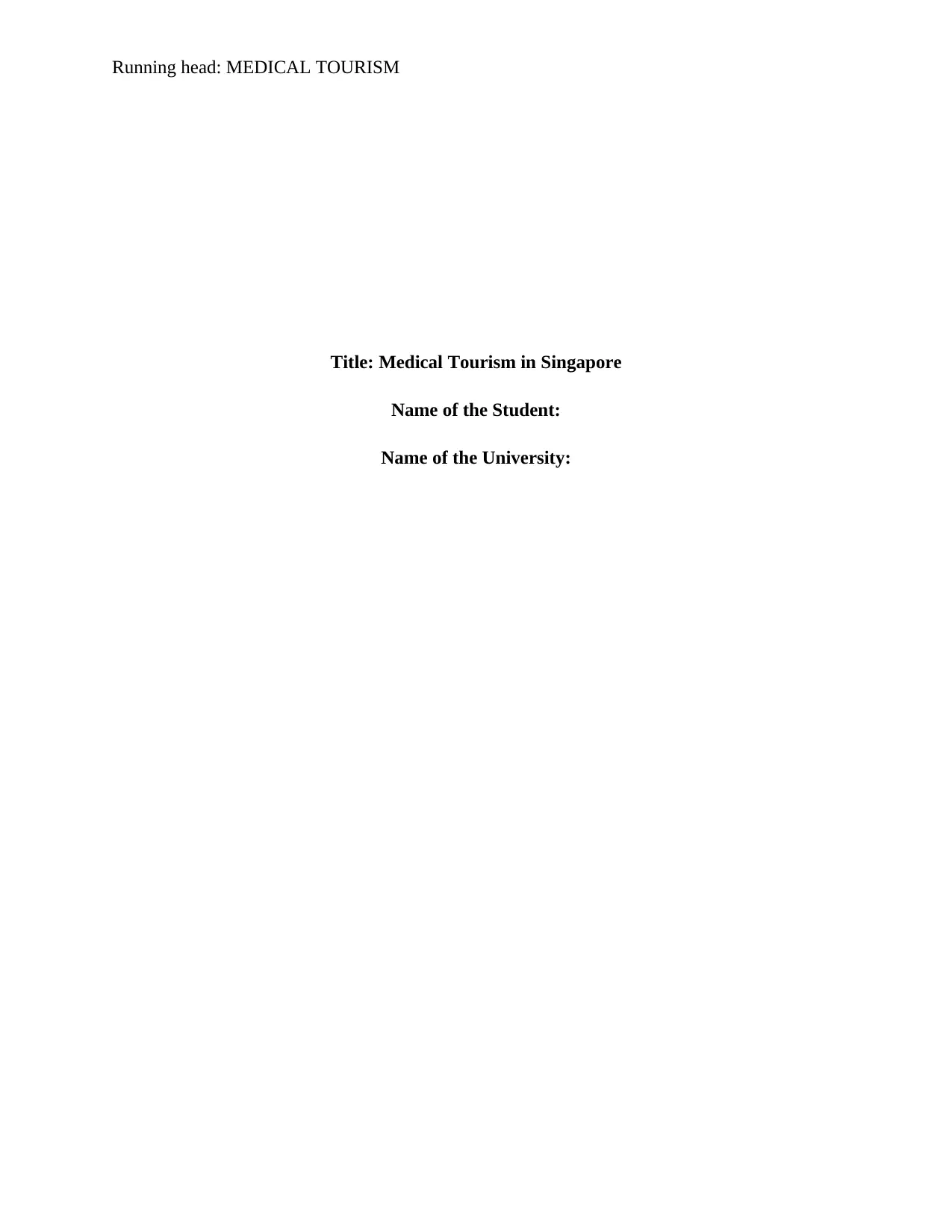
Running head: MEDICAL TOURISM
Title: Medical Tourism in Singapore
Name of the Student:
Name of the University:
Title: Medical Tourism in Singapore
Name of the Student:
Name of the University:
Paraphrase This Document
Need a fresh take? Get an instant paraphrase of this document with our AI Paraphraser
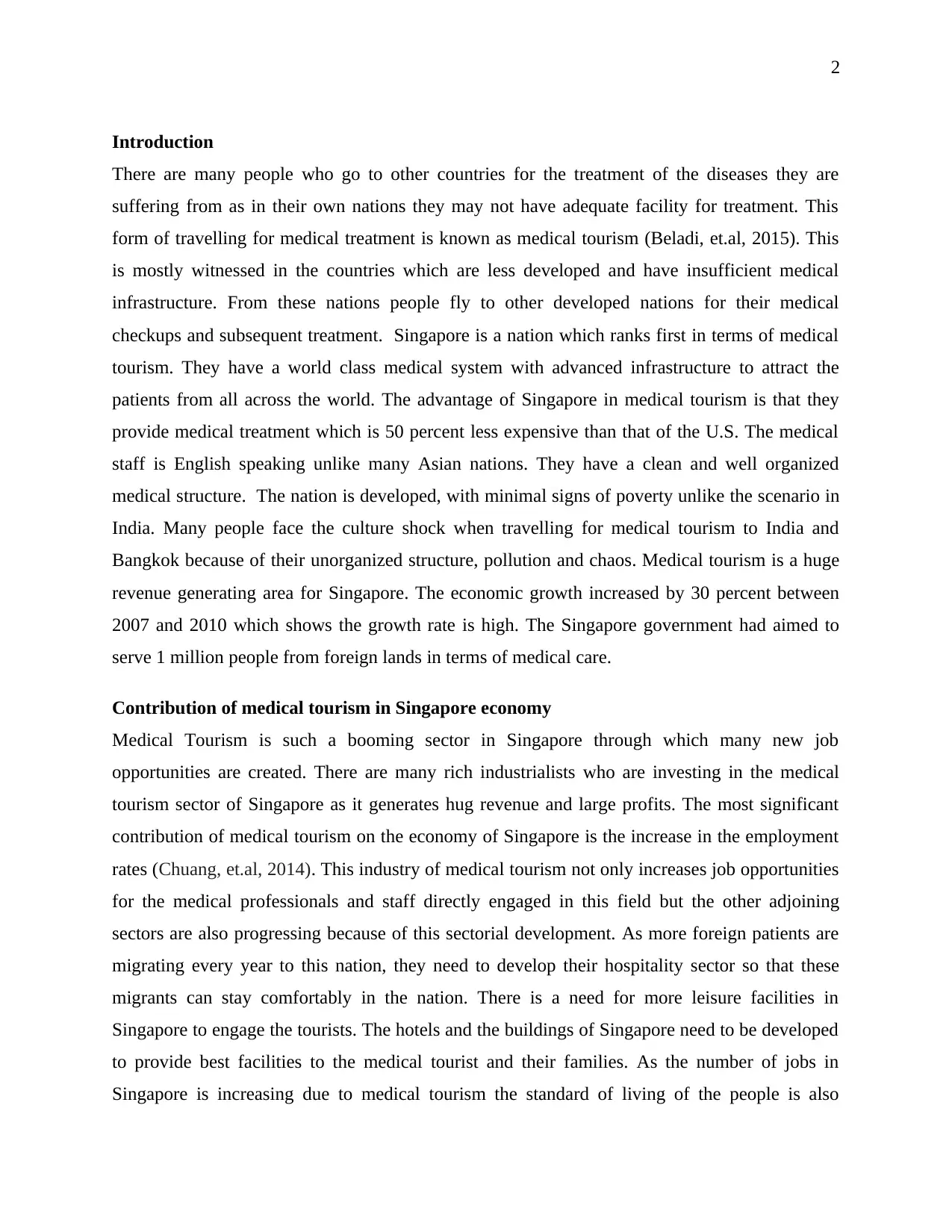
2
Introduction
There are many people who go to other countries for the treatment of the diseases they are
suffering from as in their own nations they may not have adequate facility for treatment. This
form of travelling for medical treatment is known as medical tourism (Beladi, et.al, 2015). This
is mostly witnessed in the countries which are less developed and have insufficient medical
infrastructure. From these nations people fly to other developed nations for their medical
checkups and subsequent treatment. Singapore is a nation which ranks first in terms of medical
tourism. They have a world class medical system with advanced infrastructure to attract the
patients from all across the world. The advantage of Singapore in medical tourism is that they
provide medical treatment which is 50 percent less expensive than that of the U.S. The medical
staff is English speaking unlike many Asian nations. They have a clean and well organized
medical structure. The nation is developed, with minimal signs of poverty unlike the scenario in
India. Many people face the culture shock when travelling for medical tourism to India and
Bangkok because of their unorganized structure, pollution and chaos. Medical tourism is a huge
revenue generating area for Singapore. The economic growth increased by 30 percent between
2007 and 2010 which shows the growth rate is high. The Singapore government had aimed to
serve 1 million people from foreign lands in terms of medical care.
Contribution of medical tourism in Singapore economy
Medical Tourism is such a booming sector in Singapore through which many new job
opportunities are created. There are many rich industrialists who are investing in the medical
tourism sector of Singapore as it generates hug revenue and large profits. The most significant
contribution of medical tourism on the economy of Singapore is the increase in the employment
rates (Chuang, et.al, 2014). This industry of medical tourism not only increases job opportunities
for the medical professionals and staff directly engaged in this field but the other adjoining
sectors are also progressing because of this sectorial development. As more foreign patients are
migrating every year to this nation, they need to develop their hospitality sector so that these
migrants can stay comfortably in the nation. There is a need for more leisure facilities in
Singapore to engage the tourists. The hotels and the buildings of Singapore need to be developed
to provide best facilities to the medical tourist and their families. As the number of jobs in
Singapore is increasing due to medical tourism the standard of living of the people is also
Introduction
There are many people who go to other countries for the treatment of the diseases they are
suffering from as in their own nations they may not have adequate facility for treatment. This
form of travelling for medical treatment is known as medical tourism (Beladi, et.al, 2015). This
is mostly witnessed in the countries which are less developed and have insufficient medical
infrastructure. From these nations people fly to other developed nations for their medical
checkups and subsequent treatment. Singapore is a nation which ranks first in terms of medical
tourism. They have a world class medical system with advanced infrastructure to attract the
patients from all across the world. The advantage of Singapore in medical tourism is that they
provide medical treatment which is 50 percent less expensive than that of the U.S. The medical
staff is English speaking unlike many Asian nations. They have a clean and well organized
medical structure. The nation is developed, with minimal signs of poverty unlike the scenario in
India. Many people face the culture shock when travelling for medical tourism to India and
Bangkok because of their unorganized structure, pollution and chaos. Medical tourism is a huge
revenue generating area for Singapore. The economic growth increased by 30 percent between
2007 and 2010 which shows the growth rate is high. The Singapore government had aimed to
serve 1 million people from foreign lands in terms of medical care.
Contribution of medical tourism in Singapore economy
Medical Tourism is such a booming sector in Singapore through which many new job
opportunities are created. There are many rich industrialists who are investing in the medical
tourism sector of Singapore as it generates hug revenue and large profits. The most significant
contribution of medical tourism on the economy of Singapore is the increase in the employment
rates (Chuang, et.al, 2014). This industry of medical tourism not only increases job opportunities
for the medical professionals and staff directly engaged in this field but the other adjoining
sectors are also progressing because of this sectorial development. As more foreign patients are
migrating every year to this nation, they need to develop their hospitality sector so that these
migrants can stay comfortably in the nation. There is a need for more leisure facilities in
Singapore to engage the tourists. The hotels and the buildings of Singapore need to be developed
to provide best facilities to the medical tourist and their families. As the number of jobs in
Singapore is increasing due to medical tourism the standard of living of the people is also
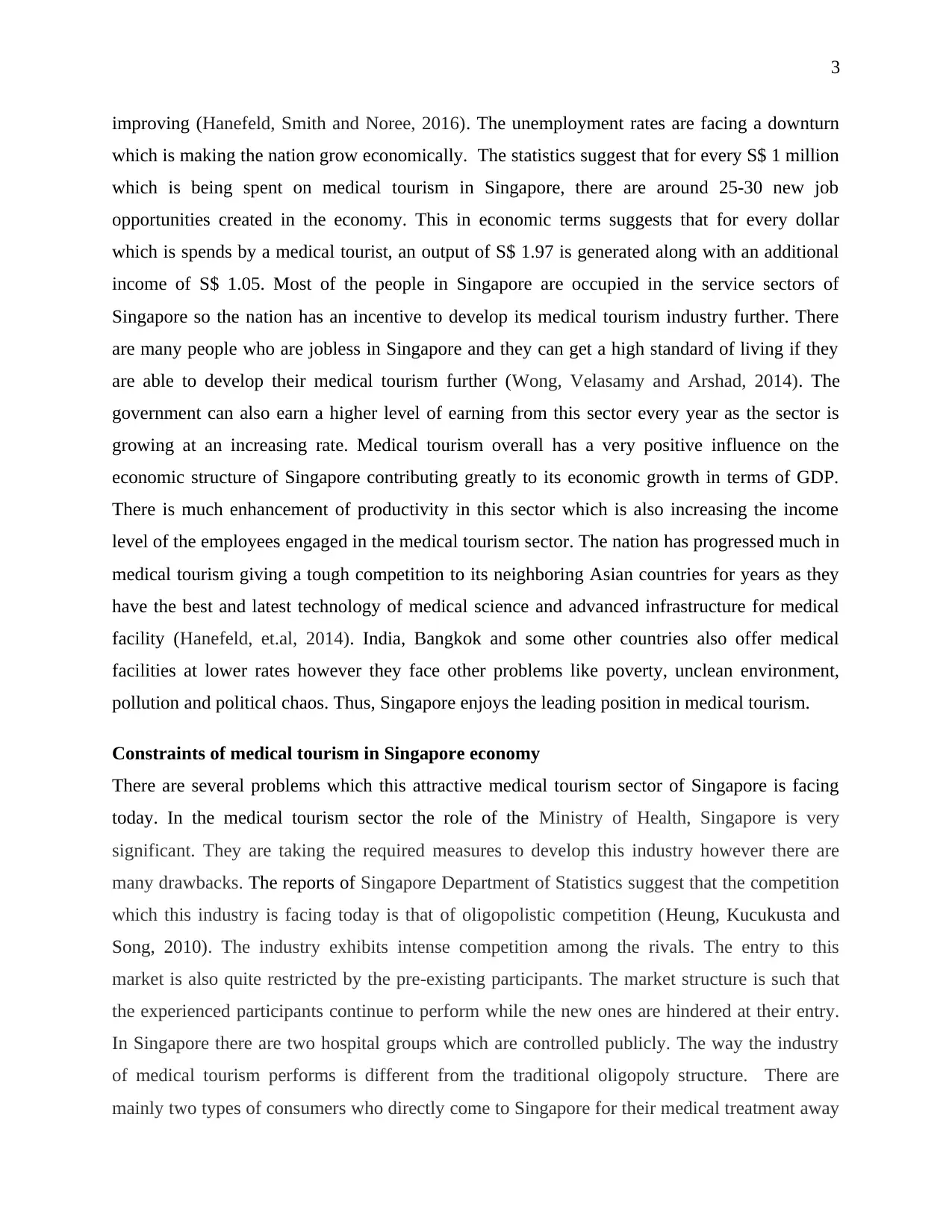
3
improving (Hanefeld, Smith and Noree, 2016). The unemployment rates are facing a downturn
which is making the nation grow economically. The statistics suggest that for every S$ 1 million
which is being spent on medical tourism in Singapore, there are around 25-30 new job
opportunities created in the economy. This in economic terms suggests that for every dollar
which is spends by a medical tourist, an output of S$ 1.97 is generated along with an additional
income of S$ 1.05. Most of the people in Singapore are occupied in the service sectors of
Singapore so the nation has an incentive to develop its medical tourism industry further. There
are many people who are jobless in Singapore and they can get a high standard of living if they
are able to develop their medical tourism further (Wong, Velasamy and Arshad, 2014). The
government can also earn a higher level of earning from this sector every year as the sector is
growing at an increasing rate. Medical tourism overall has a very positive influence on the
economic structure of Singapore contributing greatly to its economic growth in terms of GDP.
There is much enhancement of productivity in this sector which is also increasing the income
level of the employees engaged in the medical tourism sector. The nation has progressed much in
medical tourism giving a tough competition to its neighboring Asian countries for years as they
have the best and latest technology of medical science and advanced infrastructure for medical
facility (Hanefeld, et.al, 2014). India, Bangkok and some other countries also offer medical
facilities at lower rates however they face other problems like poverty, unclean environment,
pollution and political chaos. Thus, Singapore enjoys the leading position in medical tourism.
Constraints of medical tourism in Singapore economy
There are several problems which this attractive medical tourism sector of Singapore is facing
today. In the medical tourism sector the role of the Ministry of Health, Singapore is very
significant. They are taking the required measures to develop this industry however there are
many drawbacks. The reports of Singapore Department of Statistics suggest that the competition
which this industry is facing today is that of oligopolistic competition (Heung, Kucukusta and
Song, 2010). The industry exhibits intense competition among the rivals. The entry to this
market is also quite restricted by the pre-existing participants. The market structure is such that
the experienced participants continue to perform while the new ones are hindered at their entry.
In Singapore there are two hospital groups which are controlled publicly. The way the industry
of medical tourism performs is different from the traditional oligopoly structure. There are
mainly two types of consumers who directly come to Singapore for their medical treatment away
improving (Hanefeld, Smith and Noree, 2016). The unemployment rates are facing a downturn
which is making the nation grow economically. The statistics suggest that for every S$ 1 million
which is being spent on medical tourism in Singapore, there are around 25-30 new job
opportunities created in the economy. This in economic terms suggests that for every dollar
which is spends by a medical tourist, an output of S$ 1.97 is generated along with an additional
income of S$ 1.05. Most of the people in Singapore are occupied in the service sectors of
Singapore so the nation has an incentive to develop its medical tourism industry further. There
are many people who are jobless in Singapore and they can get a high standard of living if they
are able to develop their medical tourism further (Wong, Velasamy and Arshad, 2014). The
government can also earn a higher level of earning from this sector every year as the sector is
growing at an increasing rate. Medical tourism overall has a very positive influence on the
economic structure of Singapore contributing greatly to its economic growth in terms of GDP.
There is much enhancement of productivity in this sector which is also increasing the income
level of the employees engaged in the medical tourism sector. The nation has progressed much in
medical tourism giving a tough competition to its neighboring Asian countries for years as they
have the best and latest technology of medical science and advanced infrastructure for medical
facility (Hanefeld, et.al, 2014). India, Bangkok and some other countries also offer medical
facilities at lower rates however they face other problems like poverty, unclean environment,
pollution and political chaos. Thus, Singapore enjoys the leading position in medical tourism.
Constraints of medical tourism in Singapore economy
There are several problems which this attractive medical tourism sector of Singapore is facing
today. In the medical tourism sector the role of the Ministry of Health, Singapore is very
significant. They are taking the required measures to develop this industry however there are
many drawbacks. The reports of Singapore Department of Statistics suggest that the competition
which this industry is facing today is that of oligopolistic competition (Heung, Kucukusta and
Song, 2010). The industry exhibits intense competition among the rivals. The entry to this
market is also quite restricted by the pre-existing participants. The market structure is such that
the experienced participants continue to perform while the new ones are hindered at their entry.
In Singapore there are two hospital groups which are controlled publicly. The way the industry
of medical tourism performs is different from the traditional oligopoly structure. There are
mainly two types of consumers who directly come to Singapore for their medical treatment away
⊘ This is a preview!⊘
Do you want full access?
Subscribe today to unlock all pages.

Trusted by 1+ million students worldwide
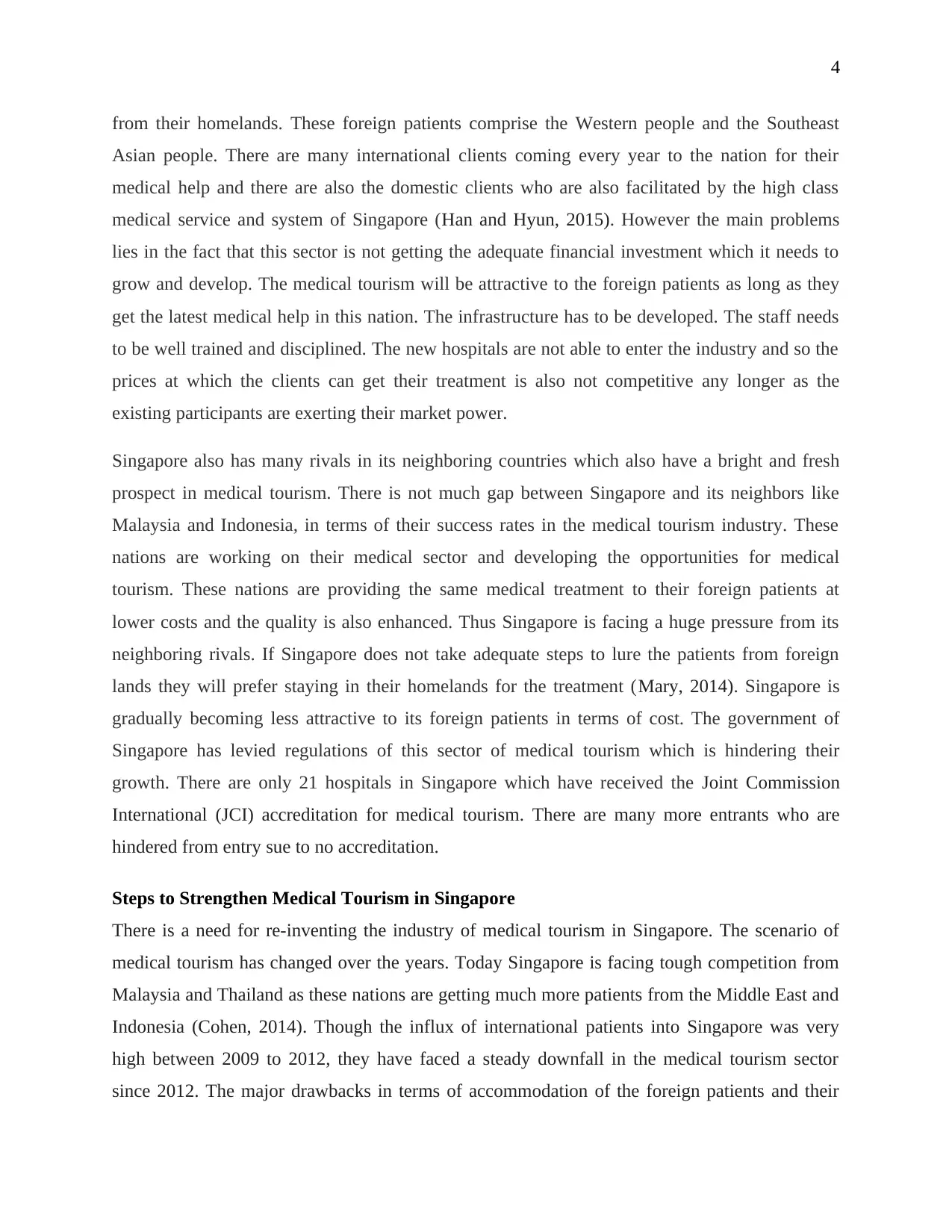
4
from their homelands. These foreign patients comprise the Western people and the Southeast
Asian people. There are many international clients coming every year to the nation for their
medical help and there are also the domestic clients who are also facilitated by the high class
medical service and system of Singapore (Han and Hyun, 2015). However the main problems
lies in the fact that this sector is not getting the adequate financial investment which it needs to
grow and develop. The medical tourism will be attractive to the foreign patients as long as they
get the latest medical help in this nation. The infrastructure has to be developed. The staff needs
to be well trained and disciplined. The new hospitals are not able to enter the industry and so the
prices at which the clients can get their treatment is also not competitive any longer as the
existing participants are exerting their market power.
Singapore also has many rivals in its neighboring countries which also have a bright and fresh
prospect in medical tourism. There is not much gap between Singapore and its neighbors like
Malaysia and Indonesia, in terms of their success rates in the medical tourism industry. These
nations are working on their medical sector and developing the opportunities for medical
tourism. These nations are providing the same medical treatment to their foreign patients at
lower costs and the quality is also enhanced. Thus Singapore is facing a huge pressure from its
neighboring rivals. If Singapore does not take adequate steps to lure the patients from foreign
lands they will prefer staying in their homelands for the treatment (Mary, 2014). Singapore is
gradually becoming less attractive to its foreign patients in terms of cost. The government of
Singapore has levied regulations of this sector of medical tourism which is hindering their
growth. There are only 21 hospitals in Singapore which have received the Joint Commission
International (JCI) accreditation for medical tourism. There are many more entrants who are
hindered from entry sue to no accreditation.
Steps to Strengthen Medical Tourism in Singapore
There is a need for re-inventing the industry of medical tourism in Singapore. The scenario of
medical tourism has changed over the years. Today Singapore is facing tough competition from
Malaysia and Thailand as these nations are getting much more patients from the Middle East and
Indonesia (Cohen, 2014). Though the influx of international patients into Singapore was very
high between 2009 to 2012, they have faced a steady downfall in the medical tourism sector
since 2012. The major drawbacks in terms of accommodation of the foreign patients and their
from their homelands. These foreign patients comprise the Western people and the Southeast
Asian people. There are many international clients coming every year to the nation for their
medical help and there are also the domestic clients who are also facilitated by the high class
medical service and system of Singapore (Han and Hyun, 2015). However the main problems
lies in the fact that this sector is not getting the adequate financial investment which it needs to
grow and develop. The medical tourism will be attractive to the foreign patients as long as they
get the latest medical help in this nation. The infrastructure has to be developed. The staff needs
to be well trained and disciplined. The new hospitals are not able to enter the industry and so the
prices at which the clients can get their treatment is also not competitive any longer as the
existing participants are exerting their market power.
Singapore also has many rivals in its neighboring countries which also have a bright and fresh
prospect in medical tourism. There is not much gap between Singapore and its neighbors like
Malaysia and Indonesia, in terms of their success rates in the medical tourism industry. These
nations are working on their medical sector and developing the opportunities for medical
tourism. These nations are providing the same medical treatment to their foreign patients at
lower costs and the quality is also enhanced. Thus Singapore is facing a huge pressure from its
neighboring rivals. If Singapore does not take adequate steps to lure the patients from foreign
lands they will prefer staying in their homelands for the treatment (Mary, 2014). Singapore is
gradually becoming less attractive to its foreign patients in terms of cost. The government of
Singapore has levied regulations of this sector of medical tourism which is hindering their
growth. There are only 21 hospitals in Singapore which have received the Joint Commission
International (JCI) accreditation for medical tourism. There are many more entrants who are
hindered from entry sue to no accreditation.
Steps to Strengthen Medical Tourism in Singapore
There is a need for re-inventing the industry of medical tourism in Singapore. The scenario of
medical tourism has changed over the years. Today Singapore is facing tough competition from
Malaysia and Thailand as these nations are getting much more patients from the Middle East and
Indonesia (Cohen, 2014). Though the influx of international patients into Singapore was very
high between 2009 to 2012, they have faced a steady downfall in the medical tourism sector
since 2012. The major drawbacks in terms of accommodation of the foreign patients and their
Paraphrase This Document
Need a fresh take? Get an instant paraphrase of this document with our AI Paraphraser
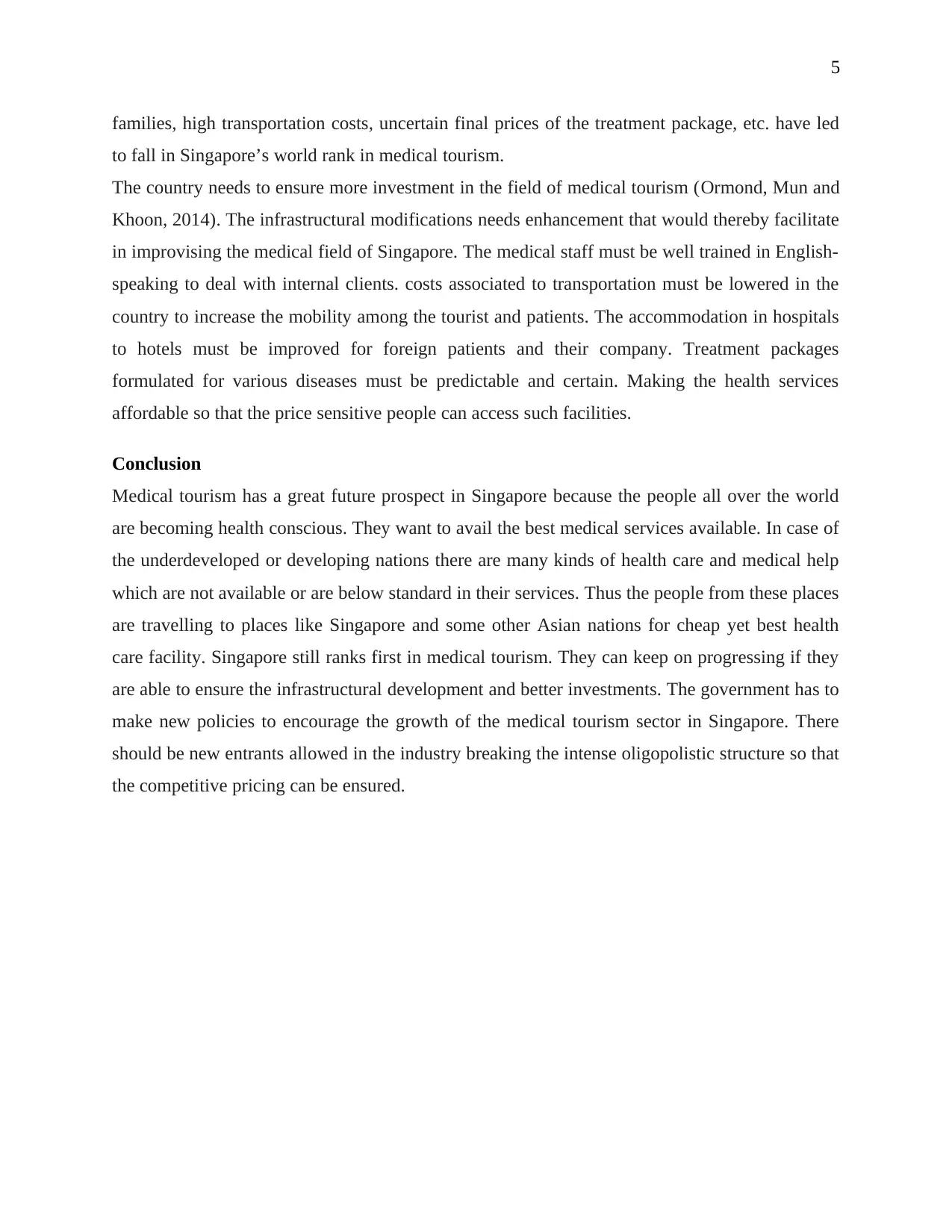
5
families, high transportation costs, uncertain final prices of the treatment package, etc. have led
to fall in Singapore’s world rank in medical tourism.
The country needs to ensure more investment in the field of medical tourism (Ormond, Mun and
Khoon, 2014). The infrastructural modifications needs enhancement that would thereby facilitate
in improvising the medical field of Singapore. The medical staff must be well trained in English-
speaking to deal with internal clients. costs associated to transportation must be lowered in the
country to increase the mobility among the tourist and patients. The accommodation in hospitals
to hotels must be improved for foreign patients and their company. Treatment packages
formulated for various diseases must be predictable and certain. Making the health services
affordable so that the price sensitive people can access such facilities.
Conclusion
Medical tourism has a great future prospect in Singapore because the people all over the world
are becoming health conscious. They want to avail the best medical services available. In case of
the underdeveloped or developing nations there are many kinds of health care and medical help
which are not available or are below standard in their services. Thus the people from these places
are travelling to places like Singapore and some other Asian nations for cheap yet best health
care facility. Singapore still ranks first in medical tourism. They can keep on progressing if they
are able to ensure the infrastructural development and better investments. The government has to
make new policies to encourage the growth of the medical tourism sector in Singapore. There
should be new entrants allowed in the industry breaking the intense oligopolistic structure so that
the competitive pricing can be ensured.
families, high transportation costs, uncertain final prices of the treatment package, etc. have led
to fall in Singapore’s world rank in medical tourism.
The country needs to ensure more investment in the field of medical tourism (Ormond, Mun and
Khoon, 2014). The infrastructural modifications needs enhancement that would thereby facilitate
in improvising the medical field of Singapore. The medical staff must be well trained in English-
speaking to deal with internal clients. costs associated to transportation must be lowered in the
country to increase the mobility among the tourist and patients. The accommodation in hospitals
to hotels must be improved for foreign patients and their company. Treatment packages
formulated for various diseases must be predictable and certain. Making the health services
affordable so that the price sensitive people can access such facilities.
Conclusion
Medical tourism has a great future prospect in Singapore because the people all over the world
are becoming health conscious. They want to avail the best medical services available. In case of
the underdeveloped or developing nations there are many kinds of health care and medical help
which are not available or are below standard in their services. Thus the people from these places
are travelling to places like Singapore and some other Asian nations for cheap yet best health
care facility. Singapore still ranks first in medical tourism. They can keep on progressing if they
are able to ensure the infrastructural development and better investments. The government has to
make new policies to encourage the growth of the medical tourism sector in Singapore. There
should be new entrants allowed in the industry breaking the intense oligopolistic structure so that
the competitive pricing can be ensured.
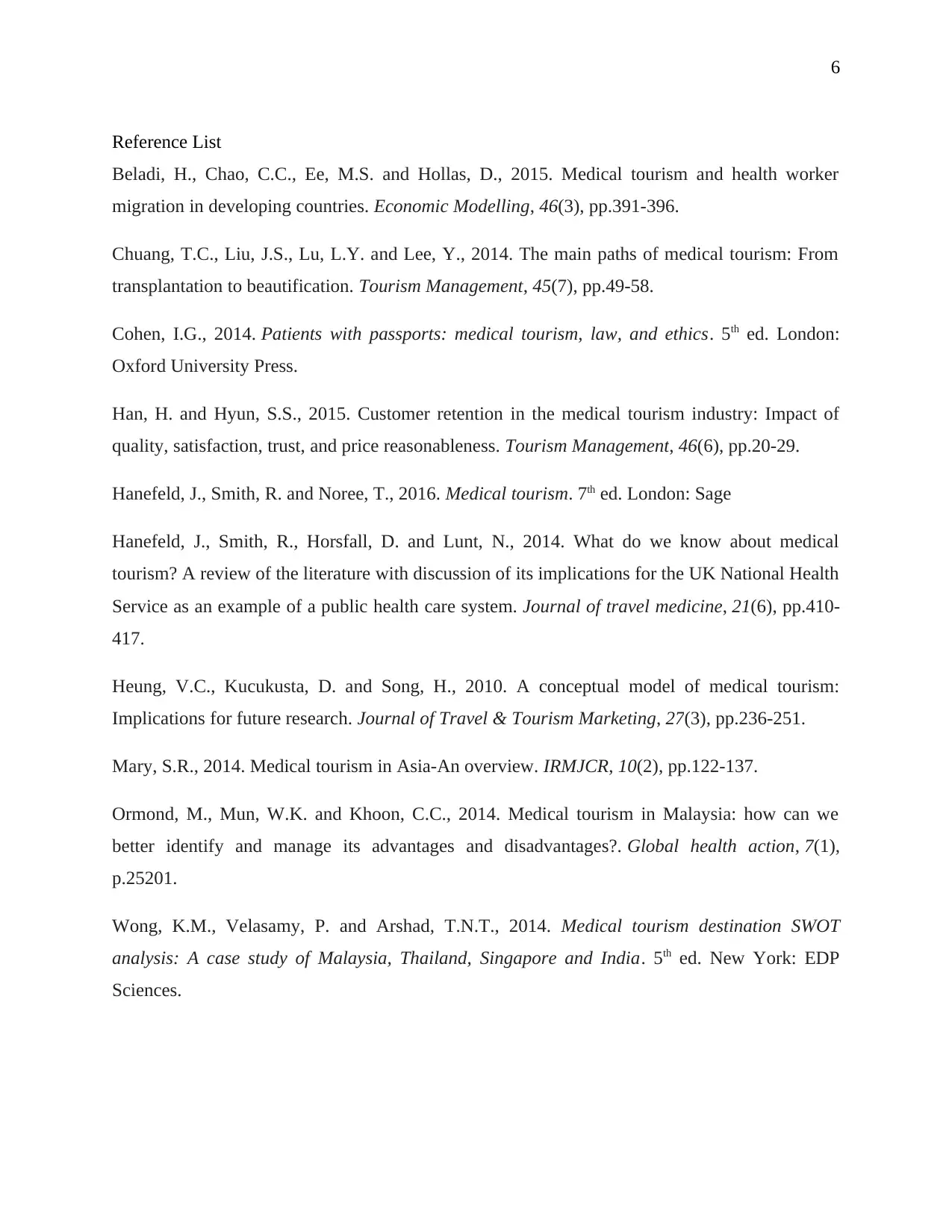
6
Reference List
Beladi, H., Chao, C.C., Ee, M.S. and Hollas, D., 2015. Medical tourism and health worker
migration in developing countries. Economic Modelling, 46(3), pp.391-396.
Chuang, T.C., Liu, J.S., Lu, L.Y. and Lee, Y., 2014. The main paths of medical tourism: From
transplantation to beautification. Tourism Management, 45(7), pp.49-58.
Cohen, I.G., 2014. Patients with passports: medical tourism, law, and ethics. 5th ed. London:
Oxford University Press.
Han, H. and Hyun, S.S., 2015. Customer retention in the medical tourism industry: Impact of
quality, satisfaction, trust, and price reasonableness. Tourism Management, 46(6), pp.20-29.
Hanefeld, J., Smith, R. and Noree, T., 2016. Medical tourism. 7th ed. London: Sage
Hanefeld, J., Smith, R., Horsfall, D. and Lunt, N., 2014. What do we know about medical
tourism? A review of the literature with discussion of its implications for the UK National Health
Service as an example of a public health care system. Journal of travel medicine, 21(6), pp.410-
417.
Heung, V.C., Kucukusta, D. and Song, H., 2010. A conceptual model of medical tourism:
Implications for future research. Journal of Travel & Tourism Marketing, 27(3), pp.236-251.
Mary, S.R., 2014. Medical tourism in Asia-An overview. IRMJCR, 10(2), pp.122-137.
Ormond, M., Mun, W.K. and Khoon, C.C., 2014. Medical tourism in Malaysia: how can we
better identify and manage its advantages and disadvantages?. Global health action, 7(1),
p.25201.
Wong, K.M., Velasamy, P. and Arshad, T.N.T., 2014. Medical tourism destination SWOT
analysis: A case study of Malaysia, Thailand, Singapore and India. 5th ed. New York: EDP
Sciences.
Reference List
Beladi, H., Chao, C.C., Ee, M.S. and Hollas, D., 2015. Medical tourism and health worker
migration in developing countries. Economic Modelling, 46(3), pp.391-396.
Chuang, T.C., Liu, J.S., Lu, L.Y. and Lee, Y., 2014. The main paths of medical tourism: From
transplantation to beautification. Tourism Management, 45(7), pp.49-58.
Cohen, I.G., 2014. Patients with passports: medical tourism, law, and ethics. 5th ed. London:
Oxford University Press.
Han, H. and Hyun, S.S., 2015. Customer retention in the medical tourism industry: Impact of
quality, satisfaction, trust, and price reasonableness. Tourism Management, 46(6), pp.20-29.
Hanefeld, J., Smith, R. and Noree, T., 2016. Medical tourism. 7th ed. London: Sage
Hanefeld, J., Smith, R., Horsfall, D. and Lunt, N., 2014. What do we know about medical
tourism? A review of the literature with discussion of its implications for the UK National Health
Service as an example of a public health care system. Journal of travel medicine, 21(6), pp.410-
417.
Heung, V.C., Kucukusta, D. and Song, H., 2010. A conceptual model of medical tourism:
Implications for future research. Journal of Travel & Tourism Marketing, 27(3), pp.236-251.
Mary, S.R., 2014. Medical tourism in Asia-An overview. IRMJCR, 10(2), pp.122-137.
Ormond, M., Mun, W.K. and Khoon, C.C., 2014. Medical tourism in Malaysia: how can we
better identify and manage its advantages and disadvantages?. Global health action, 7(1),
p.25201.
Wong, K.M., Velasamy, P. and Arshad, T.N.T., 2014. Medical tourism destination SWOT
analysis: A case study of Malaysia, Thailand, Singapore and India. 5th ed. New York: EDP
Sciences.
⊘ This is a preview!⊘
Do you want full access?
Subscribe today to unlock all pages.

Trusted by 1+ million students worldwide

7
1 out of 7
Related Documents
Your All-in-One AI-Powered Toolkit for Academic Success.
+13062052269
info@desklib.com
Available 24*7 on WhatsApp / Email
![[object Object]](/_next/static/media/star-bottom.7253800d.svg)
Unlock your academic potential
Copyright © 2020–2025 A2Z Services. All Rights Reserved. Developed and managed by ZUCOL.





